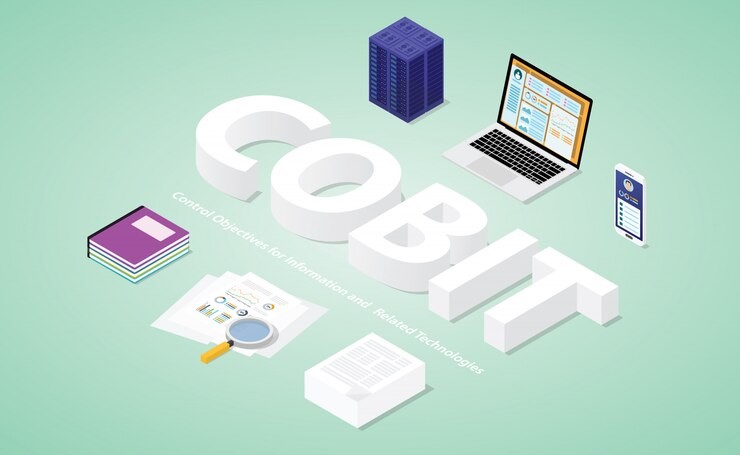Table of Contents
ToggleControl Objectives for Information and Related Technologies, or COBIT, is a broad and comprehensive framework that industries use to support understanding, designing, and implementing the management and governance of enterprise IT (EGIT). The bond between management and governance of enterprise IT is enhanced by using the COBIT framework, as it helps businesses achieve their goals. Besides, the COBIT framework provides valuable insights into the components, enablers, and principles that play a crucial role in effective IT governance and management. This blog will explain the necessary components of the COBIT Foundation, the difference between its versions, why industries rely on COBIT, and so on.
What is COBIT?
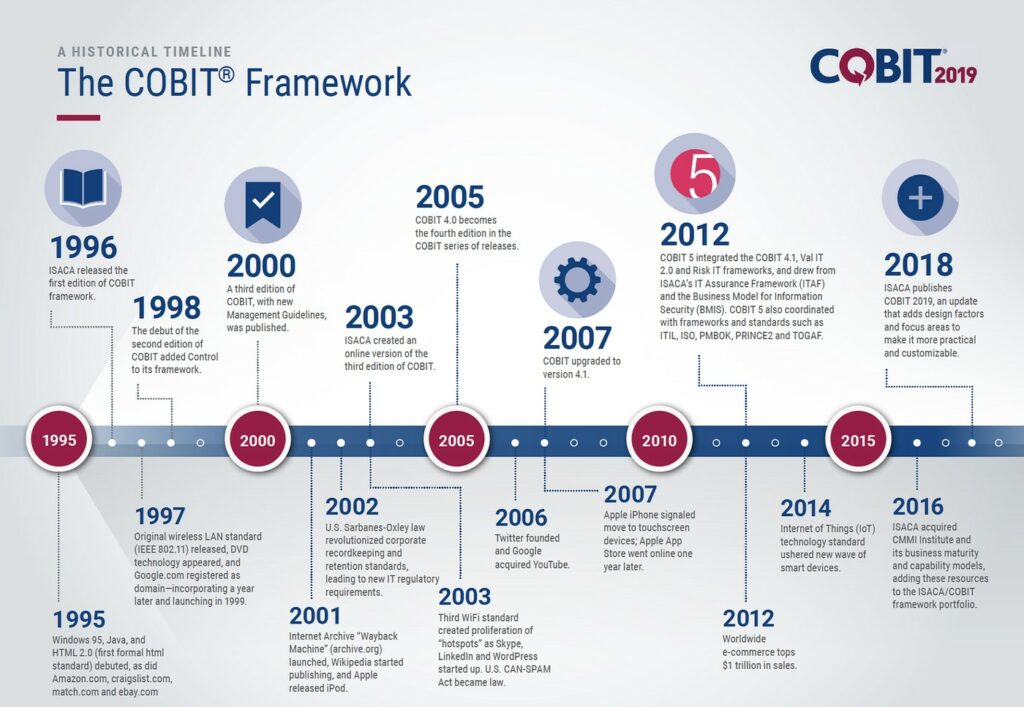
Image source: ISACA
‘The COBIT Foundation certificate validates your understanding of how to align IT goals with strategic business objectives—including the value derived from IT, necessary resources, and potential risks in the process of building a mature relationship between the business and IT.”
According to an ISACA report, more than 90% of the executives who have used COBIT would recommend it to other companies. A significant transformation has occurred in the IT landscape in the past decade. The rise in the importance of securing company assets and managing risks has made governance a crucial aspect for organizations. The release of COBIT 5 in 2012 marked a pivotal moment in addressing these challenges. However, given the evolving threat landscape and growing concerns, the introduction of COBIT 2019 aims to provide organizations with an adaptable framework to navigate and address emerging issues effectively.
We’ll discuss thoroughly the difference between the COBIT 5 and COBIT 2019 certifications in the later sections of this blog.
COBIT extends beyond a collection of technical standards tailored for IT managers. This framework aligns with business needs through the integration of IT applications, associated processes, and resources. It encompasses two primary parameters:
- Control: Encompassing IT management practices, policies, procedures, and structures, COBIT ensures an acceptable level of assurance that business goals will be achieved.
- IT Control Objective: Defines the acceptable outcome level that must be achieved through the implementation of control procedures for a specific IT operation.
What is the COBIT Framework?
In its business-oriented approach, COBIT establishes a connection between business objectives and IT infrastructure. It achieves this by offering various maturity models and metrics to measure the attainment of goals while outlining the associated business responsibilities of IT processes. COBIT emphasized a process-based model, categorizing it into four distinct domains:
- Planning and Organization
- Delivering and Support
- Acquiring & Implementation
- Monitoring and evaluating
These domains are further delineated into 34 processes, each aligned with specific lines of responsibilities. COBIT holds a prominent position in business frameworks and is acknowledged in various international standards such as ITIL, CMMI, COSO, PRINCE2, TOGAF, PMBOK, TOGAF, and ISO 27000. It serves as a comprehensive guideline integrator, consolidating diverse solutions under a unified framework.

What are the Main Pillars of COBIT?
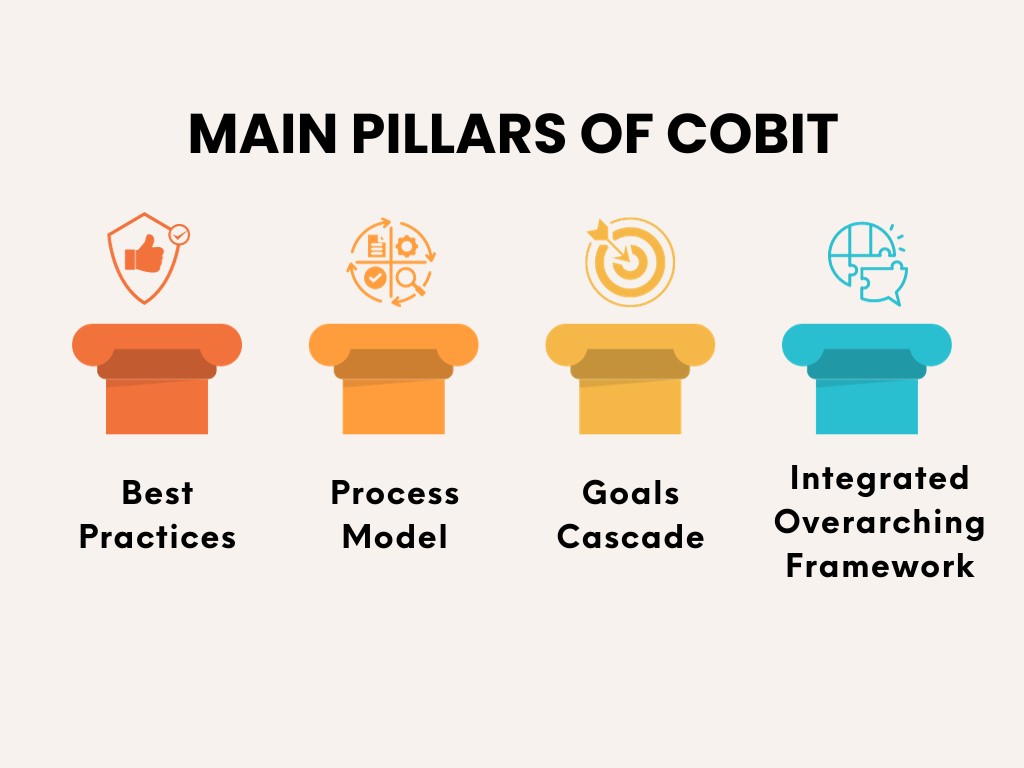
1. Best Practices
The framework offers valuable guidance for achieving value creation through a balanced approach that emphasizes benefits realization, risk optimization, and resource optimization. This ensures that all tasks are executed by established standards and rules.
2. Process Model
This model empowers practitioners to integrate enterprise information and technology activities optimally. COBIT5’s process reference model comprises key processes, while COBIT 2019 focuses on governance and management objectives.
3. Goals Cascade
The COBIT framework acknowledges the granular levels of stakeholders’ needs, enterprise goals, IT alignment goals, and enabler or component goals.
4. Integrated Overarching Framework
COBIT allows the incorporation of other relevant standards, methodologies, and frameworks, such as PRINCE2, ITIL, TOGAF, etc., within its overarching structure. This results in more effective governance and management objectives as organizations utilizing COBIT adopt and adapt relevant guidance.
COBIT 5 vs COBIT 2019

COBIT 5 was released in the year 2012 and the governing body ISACA planned a well-executed structure that included new technology and business trends in information and technology. However, even though organizations were successfully leveraging the principles of COBIT 5, they were facing threats and challenges given the rapid change in the IT landscape. All these factors led to the emergence of the new and the latest version of COBIT 5, which is COBIT 2019.
With the effective rise of IoT, cloud computing, etc., companies started facing critical challenges that COBIT 5 could not address. As the level of digital risks increases, risk management tools and strategies also need to be upgraded. Consequently, ISACA came up with COBIT-2019 so that all IT operations are fully ready to assess, manage, and mitigate all risks and remain compliant.
Let’s see the major differences between the COBIT 2019 and COBIT 5 frameworks.
Features of COBIT-2019 that COBIT-5 did not have
- COBIT 2019 facilitates establishing risk management practices with better focus and implements governance protocols fully customized to individual and organizational requirements.
- COBIT 2019 aligns closely with global risk management standards, security standards, and other universal frameworks and protocols.
- Regular updates are a feature of COBIT 2019, ensuring ongoing compatibility with emerging technologies.
- In comparison to COBIT 5, COBIT 2019 takes a more prescriptive approach in its guidelines, supporting increased integrations in governance and risk management.
- COBIT 2019 is an open-source model that actively incorporates feedback into future updates, subject to rigorous evaluation by the Steering Committee for consistency and quality.
- COBIT 2019 places a heightened emphasis on newer technologies and methodologies, including various DevOps and Agile concepts. It also considers updated operational practices in IT-enabled organizations, such as those involving cloud-based systems and outsourcing.
The table below shows the basic differences between COBIT 5 and COBIT 2019
| FACTORS | COBIT-5 | COBIT-2019 |
|---|---|---|
| Core Model | The core model of COBIT-5 is comprised of Governance Objectives and Management Objectives | COBIT-2019 also has the same model but Managed Assurance,’ the separation of Manage Programs and Projects, and other additional objectives are also introduced in this model |
| Governance Principle | It has five governance principles | It has 6 governance principles |
| No. of processes, | COBIT 5 has 37 processes | COBIT 2019 has 40 processes |
| Performance Measure | CMMI performance management scheme is used. | A 0-5 scale based on ISO/IEC 33000 is used to measure performance. |
| Enablers | Enablers are renamed as components | Enablers are included |
| Design Factors | Not Available | Available and are spread across many categories to ensure all companies can meet their organizational needs. These categories broadly encompass contextual, strategic, and tactical measures, emphasizing the enterprise-wide nature of IT governance. |
| Source | COBIT 5 is not an open-source model. It is a proprietary framework developed by ISACA, a global business technology association | COBIT 2019 is an open-source model that allows the global governance community to propose enhancements for updating the framework. This makes COBIT 2019 more flexible and relevant to the changing needs of enterprises. |
Governance Principles of COBIT 2019 vs COBIT 5
When it comes to governance principles, there are subtle yet significant differences between COBIT 5 and COBIT 2019.
| COBIT 5 | COBIT 2019 |
| Meeting Stakeholder needs to | Provide Stakeholder Value |
| Covering the Enterprise end-to-end | Holistic Approach |
| Applying a single Integrated Framework | Dynamic Governance System |
| Enabling a holistic approach | Governance Distinct from Management |
| Separating a Governance from Management | Enterprise Needs are customized |
| End-to-End Governance System |
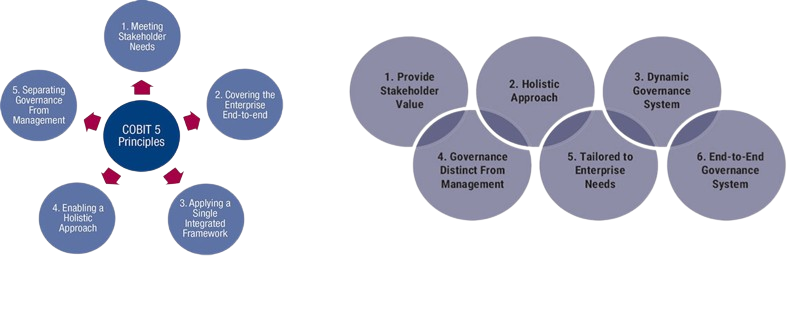
Image Source: ISACA
Three Basic Principles are Introduced in COBIT 2019
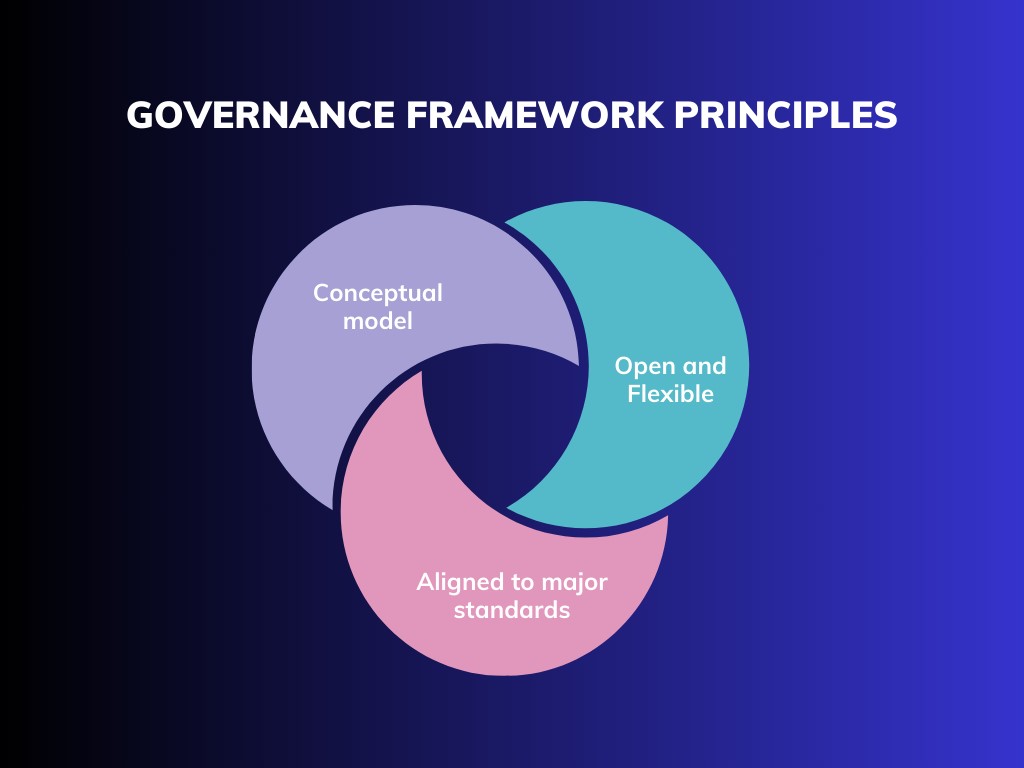
The Conceptual Model identifies critical components and their relationships to optimize consistency and enable automation. The governance framework principles of the COBIT-2019 are extremely open and flexible and encourage the addition of new content. It also addresses new issues consistently with the utmost flexibility. This model has major standards, frameworks, and regulations.
Let’s see the major changes in the direction of the framework’s processes to tackle governance and management objectives.
| COBIT 5 | COBIT 2019 |
| Terminology use: Manage | Terminology use: Managed |
| Terminology in APO10: Supplier | Terminology in APO10: Vendor |
| Align, Plan, and Organize (APO): added 1 process: APO14 Managed Data | |
| Build, Acquire and Implement (BAI): 1. Process added: BAI11 Managed Projects2. BAI06 and BAI07 indicate the changes being managed, accepted, and transitioned are IT changes | |
| Evaluate and Assess (MEA): Monitor, Evaluate, and Assess | Evaluate and Assess (MEA): Process added: MEA04 Managed Assurance |
Overview of Governance and Management Objectives of COBIT 2019 and COBIT 5 respectively:
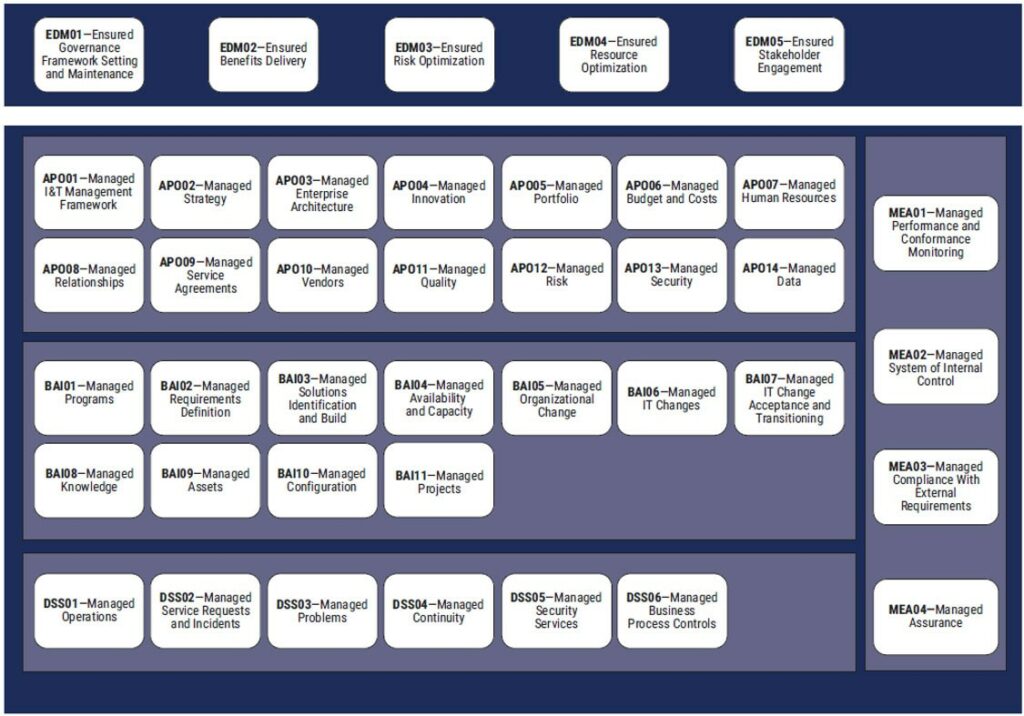
Image source: ISACA, COBIT 2019 Framework: Introduction and Methodology, USA, 2018
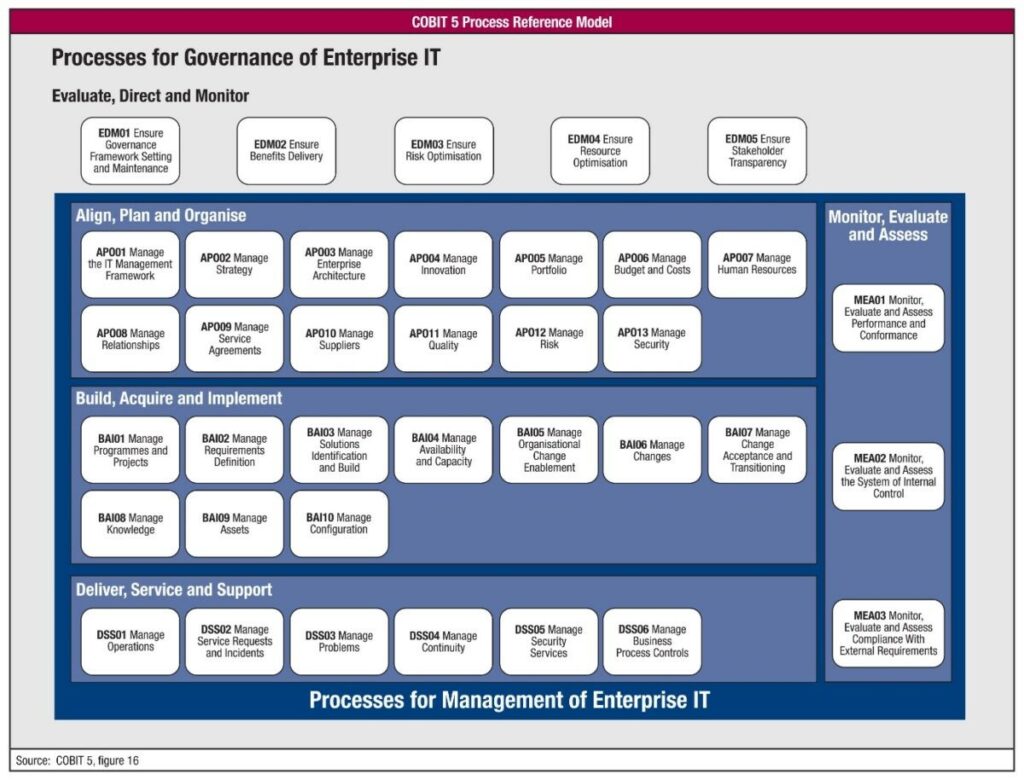
Process Capability Differences Between COBIT 5 and COBIT 2019
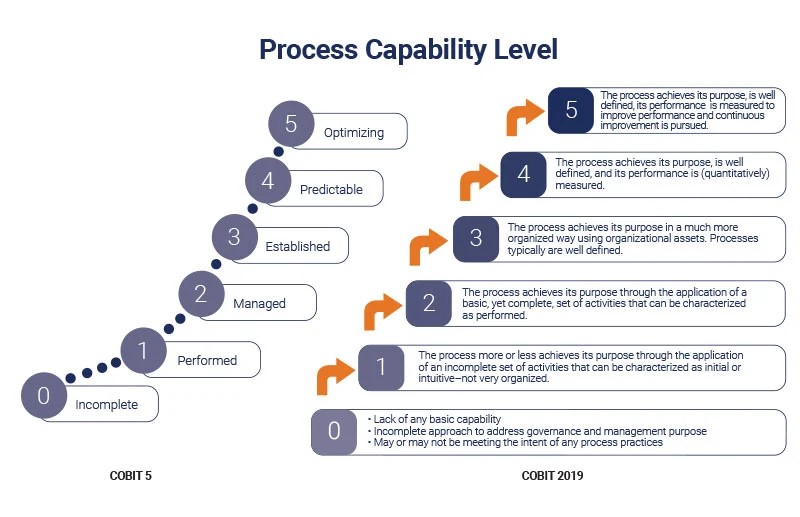
Image source: ISACA
COBIT 2019 performance management is based on the CMMI Performance Management Scheme. In this case, there are five levels between the capability and the maturity level which are marked as 0 to 5. The scale used in COBIT 5 is based on the International Organization for Standardization(ISO)/International Electrotechnical Commission (IEC) ISO/IEC 33000 Software Process Improvement and Capability Determination—SPICE.
Design Factors in COBIT-2019
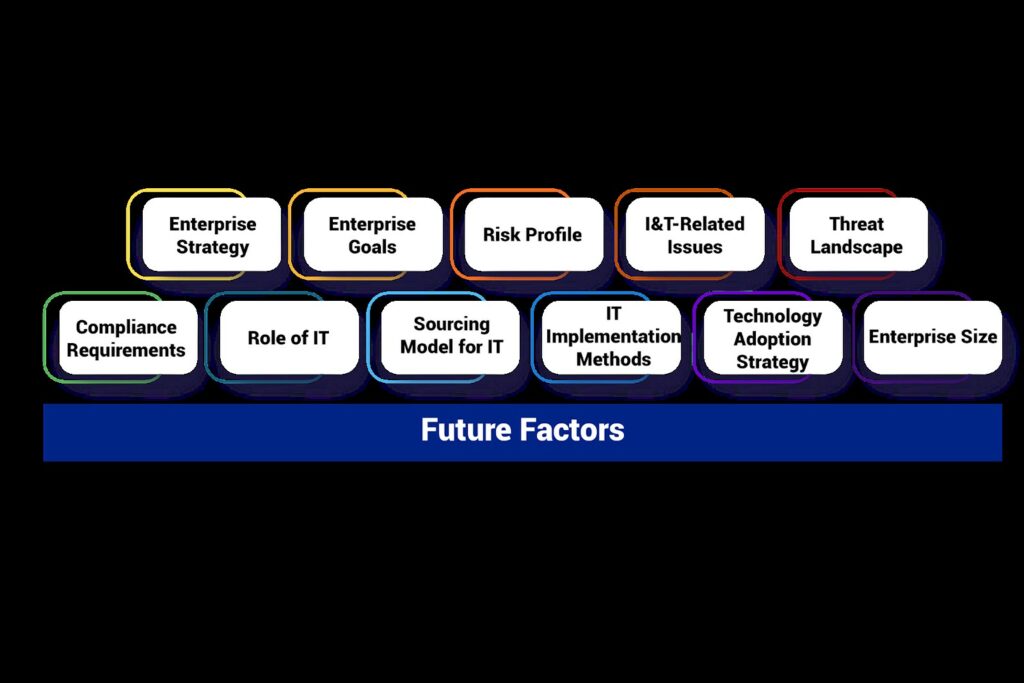
Image source: Multimatics
There are eleven design guides in the COBIT-2019 guidelines.
Design factors are pivotal in shaping a company’s governance system, positioning it for success in leveraging information and technology. These factors encompass the goals cascade of a company and comprise additional elements classified as follows: contextual factors, which extend beyond the company’s control; strategic factors, reflecting decisions made by the company; and tactical factors, involving implementation choices related to resourcing models, IT methods, and technology adoption decisions.
To attain governance and management objectives, certain components are necessary. Various design factors can influence the significance of one or more components, prompting specific changes. The final impact is articulated through targeted focus area guidance. Design factors, including the threat landscape, specialized risk, target, and others, shape this impact.

Benefits of COBIT 2019
Some of the benefits of COBIT 2019 for industries are
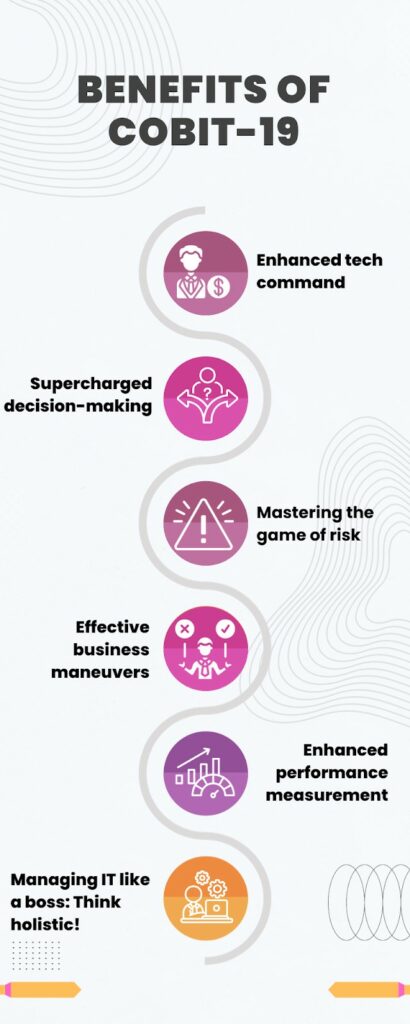
COBIT 2019 provides a clear and consistent structure for defining roles, responsibilities, and decision-making processes within an organization’s IT environment. This helps to reduce ambiguity, improve communication, and ensure accountability among stakeholders.
1. Supercharged Decision-making
COBIT 2019 supports a balanced scorecard approach that integrates financial, customer, internal process, and learning and growth perspectives. This helps to align IT investments with business value creation and measure the outcomes of IT initiatives.
2. Mastering the Game of Risk
COBIT 2019 helps organizations identify, assess, prioritize, treat, monitor, and report on the risks that affect their IT performance. It also guides how to implement risk-based controls and compliance programs.
3. Effective Business Maneuvers
COBIT 2019 helps organizations design, build, run, monitor, evaluate, and improve their IT processes based on best practices and industry standards. It also helps optimize resource use and leverage emerging technologies such as cloud computing, artificial intelligence, and blockchain.
4. Enhanced Performance Measurement
COBIT 2019 provides a comprehensive set of metrics and indicators that help organizations track their progress toward achieving their goals. It also helps to benchmark their performance against peers and industry standards.
5. Managing IT like a Boss: Think Holistically!
COBIT 2019 covers all aspects of IT management, from strategy to operations. It also integrates with other frameworks such as ISO/IEC 27001 (information security management), ISO/IEC 20000 (service management), ISO/IEC 38500 (quality management), ISO/IEC 31000 (risk management), ISO/IEC 33000 (control systems), ISO/IEC 30100 (business continuity management), ISO/IEC 31010 (life cycle approach to risk management), ISO/IEC 31020 (risk assessment techniques), ISO/IEC 31030 (risk treatment techniques), ISO/IEC 31040 (risk communication techniques), ISO/IEC 31050 (risk monitoring techniques), ISO/IEC 31060 (risk reporting techniques).
Conclusion
COBIT 2019 is enhancing the effectiveness of businesses and helping millions of organizations to create robust security along with amazing risk management. The demand in the market for professionals with a COBIT-2019 certification is quite high, given the rise of risk in the corporate world. It’s high time that you upgrade yourself to a COBIT-2019 Certification accredited by ISACA, even if you have a COBIT-5 certification. With major changes in COBIT-2019, you’ll be exposed to customized risk management and IT governance security systems that, in turn, will enhance the security of organizations.
